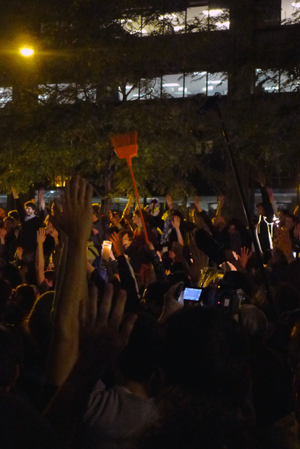Posts Tagged ‘New york’
 This Is What 2012 Looks Like
This Is What 2012 Looks Like
by Ayesha Adamo
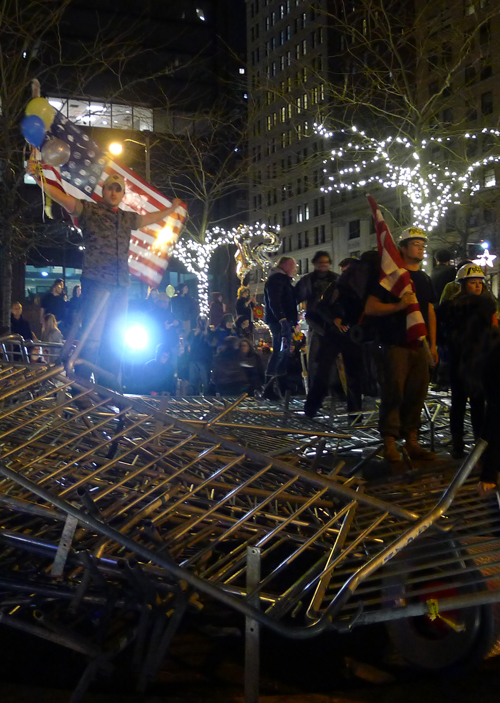 This is what 2012 looks like, in case you were wondering. I spent my New Year's Eve in Liberty Square here in New York, ready to occupy the New Year. If you were there, then you know. If you weren't, then let me tell you that as I watched the team from Direct Action swoop in and pull barricades down, winning a tug-of-war against the cops who were outnumbered for once, thanks to the festivities in Times Square, I knew that this was the best New Year's Eve of my life.
I knew it even more so as I, with my fellow occupiers, climbed the great pile of barricades that the people had tossed into the middle of the park. We stood on top, looked out over the sea of faces that had gathered, and shook the ground. And you could just tell—the myths are finally here: this is what 2012 was always meant to be. This is what I've been waiting for all my life.
Later the NYPD battalions in riot gear would descend upon the park, kicking out the few of us who decided not to go on the march to the East Village, but it was already too late: the ground had already been shaken and the barricades had already toppled. The symbol, the ritual, had already been completed, set into motion...the magick button had been pressed and no matter how many arrests were made that night, nothing could change it. Standing outside the 9th Precinct at 4 in the morning to cheer our warriors as they exited the paddy wagon, and get an idea of names to pass on to the National Lawyers Guild, the night was winding down, but with the knowledge that nothing was over. Far far from it. Viva la revolución! Viva 2012!
This is what 2012 looks like, in case you were wondering. I spent my New Year's Eve in Liberty Square here in New York, ready to occupy the New Year. If you were there, then you know. If you weren't, then let me tell you that as I watched the team from Direct Action swoop in and pull barricades down, winning a tug-of-war against the cops who were outnumbered for once, thanks to the festivities in Times Square, I knew that this was the best New Year's Eve of my life.
I knew it even more so as I, with my fellow occupiers, climbed the great pile of barricades that the people had tossed into the middle of the park. We stood on top, looked out over the sea of faces that had gathered, and shook the ground. And you could just tell—the myths are finally here: this is what 2012 was always meant to be. This is what I've been waiting for all my life.
Later the NYPD battalions in riot gear would descend upon the park, kicking out the few of us who decided not to go on the march to the East Village, but it was already too late: the ground had already been shaken and the barricades had already toppled. The symbol, the ritual, had already been completed, set into motion...the magick button had been pressed and no matter how many arrests were made that night, nothing could change it. Standing outside the 9th Precinct at 4 in the morning to cheer our warriors as they exited the paddy wagon, and get an idea of names to pass on to the National Lawyers Guild, the night was winding down, but with the knowledge that nothing was over. Far far from it. Viva la revolución! Viva 2012!
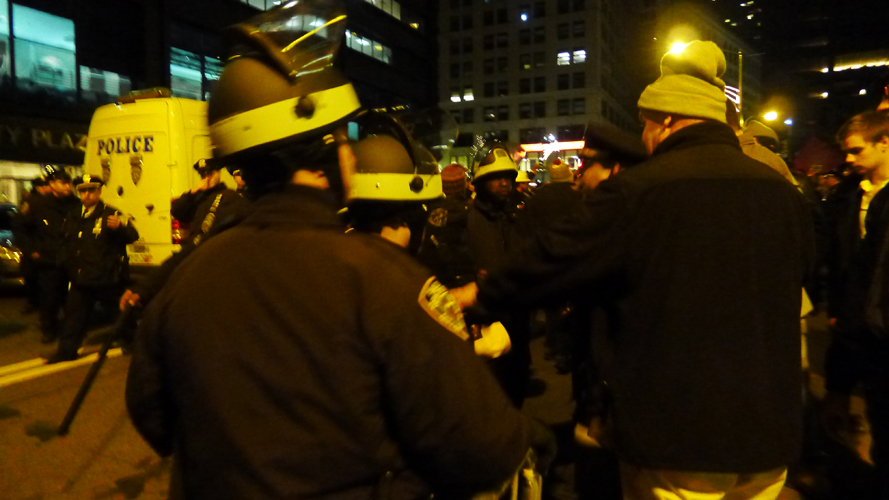
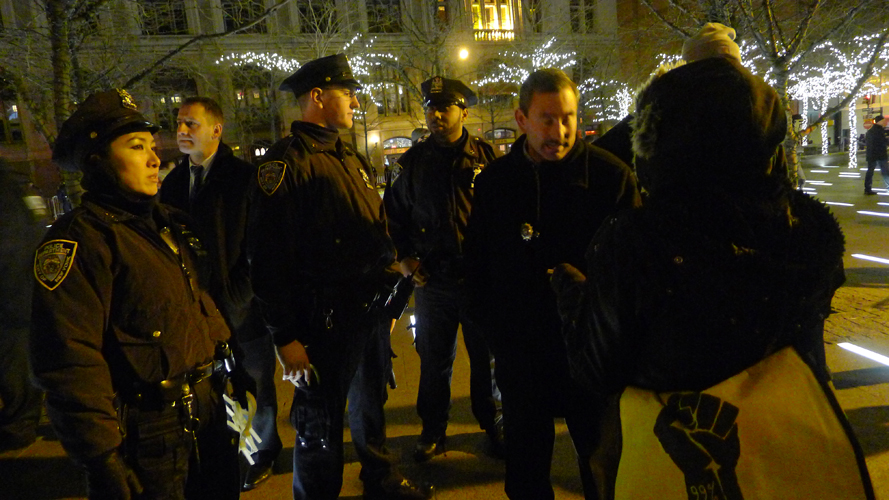
 This is what 2012 looks like, in case you were wondering. I spent my New Year's Eve in Liberty Square here in New York, ready to occupy the New Year. If you were there, then you know. If you weren't, then let me tell you that as I watched the team from Direct Action swoop in and pull barricades down, winning a tug-of-war against the cops who were outnumbered for once, thanks to the festivities in Times Square, I knew that this was the best New Year's Eve of my life.
I knew it even more so as I, with my fellow occupiers, climbed the great pile of barricades that the people had tossed into the middle of the park. We stood on top, looked out over the sea of faces that had gathered, and shook the ground. And you could just tell—the myths are finally here: this is what 2012 was always meant to be. This is what I've been waiting for all my life.
Later the NYPD battalions in riot gear would descend upon the park, kicking out the few of us who decided not to go on the march to the East Village, but it was already too late: the ground had already been shaken and the barricades had already toppled. The symbol, the ritual, had already been completed, set into motion...the magick button had been pressed and no matter how many arrests were made that night, nothing could change it. Standing outside the 9th Precinct at 4 in the morning to cheer our warriors as they exited the paddy wagon, and get an idea of names to pass on to the National Lawyers Guild, the night was winding down, but with the knowledge that nothing was over. Far far from it. Viva la revolución! Viva 2012!
This is what 2012 looks like, in case you were wondering. I spent my New Year's Eve in Liberty Square here in New York, ready to occupy the New Year. If you were there, then you know. If you weren't, then let me tell you that as I watched the team from Direct Action swoop in and pull barricades down, winning a tug-of-war against the cops who were outnumbered for once, thanks to the festivities in Times Square, I knew that this was the best New Year's Eve of my life.
I knew it even more so as I, with my fellow occupiers, climbed the great pile of barricades that the people had tossed into the middle of the park. We stood on top, looked out over the sea of faces that had gathered, and shook the ground. And you could just tell—the myths are finally here: this is what 2012 was always meant to be. This is what I've been waiting for all my life.
Later the NYPD battalions in riot gear would descend upon the park, kicking out the few of us who decided not to go on the march to the East Village, but it was already too late: the ground had already been shaken and the barricades had already toppled. The symbol, the ritual, had already been completed, set into motion...the magick button had been pressed and no matter how many arrests were made that night, nothing could change it. Standing outside the 9th Precinct at 4 in the morning to cheer our warriors as they exited the paddy wagon, and get an idea of names to pass on to the National Lawyers Guild, the night was winding down, but with the knowledge that nothing was over. Far far from it. Viva la revolución! Viva 2012!


 Four-letter words like Love and Hope
Four-letter words like Love and Hope
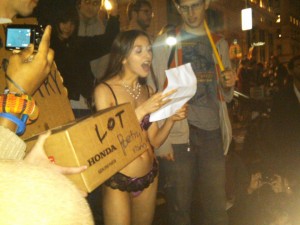 Sometimes a song comes along with a shitty, repetitive chorus, and it all goes down like melba toast…like when John Mayer once encouraged us to “Say what (we) mean to say” in eight not-so-different ways. Other times, there’s the repetitive chorus that we’re meant to be able to remember—even while shit-faced on Patron…like when Taio Cruz tells that “Little Bad Girl” to just “Go” already, stamping along in time to some David Guetta beats.
But once in a while the simplest, most repetitive phrase in a song can mean everything. This is when you’re breathing that rare air of The Doors’ “Indian Summer.” Jim Morrison and Robby Krieger work their magic(k), and suddenly, “I love you the best. Better than all the rest” is like the most profound lyric you’ve ever heard. Sometimes a pop song comes along and hits in just the right way, at just the right time. Such is the case with Rihanna’s new song, “We Found Love.”
“We found love in a hopeless place.” There it is: the moment. You don’t need to say anything else. There’s no need to riff on an explanation of that; you’ve probably known what it means since the beginning of time. “We found love in a hopeless place.” That’s everything. You know exactly what it is.
Hearing this song while thrift store shopping for used clothes that the character in my new play might wear does things to me. Powerful things. It’s like a huge homage to a time in my life when I did have hope, and I don’t just mean a general kind of universal hope for the future, the suspension of doom that was the 1990’s, I mean on a personal level. It’s those opening synth sounds that remind you of Crystal Waters’ “Gypsy Woman”…it’s like you already know this song, could recognize it anywhere, always knew it. When you listen to what Calvin Harris did, the reference to 90’s house music right from the very first moments of the track, already you’re transported to a time when people weren’t glued to their cell phones or email, when there was this new kind of strangely innocent thing, this dance music, this acid house, this scene that had its grisly dark side of OD’s on the dancefloor, but more than that just had a lot of love. This is the synthesized voice of love in analog.
And then there’s the video. This is no Lady Gaga over-priced hack-job imitation of the material girl’s ambitiously blond anthology, in which Gaga, the born-rich “artiste,” stares gauntly into the camera in an attempt to convince you that there’s something big and emotional and powerful in her when in fact it’s just another shade of neon in her vacancy sign.
No!
The beauty from Barbados actually feels things in this video and we feel them too. The people who put this video together knew what the hell they were doing. They stole all the right stuff: the dilating pupils and bathtub moments from Requiem for a Dream, the grey-skied open fields and flop houses from Trainspotting…this is divine 90’s montage: this video is perfect. It’s perfect because it’s actually presenting images from an era that was hopeful, in the same way that Harris’ musical track calls on the sounds of some seemingly-ancient rave time, so you feel the hopelessness of now even more. Sure, they could have shown images of children playing joyfully by fracking wells, or couples embracing while on the unemployment line in, like, Gary, Indiana or something. That would have been love in a hopeless place too, but that would have been too explicit. All that is already implied. And it doesn’t matter that there are shades of Rihanna and Chris Brown’s relationship in the video. Nobody cares. Chris Brown is just fuel for the story. And the story is beautiful. This past weekend, a poet friend of mine asked me if I've ever really been in love. I think you know love when you see it and the real thing looks just like this music video and sounds just like this song. I might as well just say it: I wish I could afford to do something this good…and I can’t.
Instead, I spend time at Zuccotti Park and sometimes I sing down there with just the voice that I have, a voice that can almost sort of compete with the sound of jack-hammers and the general assembly. And it is beautiful. It is one of the only beautiful things I’ve experienced for myself as a performer in a long time. It is beautiful, but it is small. Too small for me. I always long to do something meaningful. I’m not always that hopeful about it. For now, I’m just one RSS feed in a giant trough of RSS feed. So I become a part of something, something that I’m already a part of: the 99 percent. I’m no Rihanna. I wish I could be Rihanna. I wish this were my song, but I’m faceless and nameless and the best my voice can hope for is to be a part of the roar of the great din, the crashing on the shore, which has its own cacophonous majesty. In a sea of stars, there’s no shine in particular, just sameness. But it’s an amazing kind of sameness. Invisibility is a kind of superhero power too. This coming moment might be the end of the era of having a name. In so many Guy Fawkes masks, we’re all Anonymous and who knows what kind of songs will come from the nameless, but maybe we will find a more hopeful place.
Thanks to Michael Geffner for the photo at OWS Poetry Assembly, above.
Sometimes a song comes along with a shitty, repetitive chorus, and it all goes down like melba toast…like when John Mayer once encouraged us to “Say what (we) mean to say” in eight not-so-different ways. Other times, there’s the repetitive chorus that we’re meant to be able to remember—even while shit-faced on Patron…like when Taio Cruz tells that “Little Bad Girl” to just “Go” already, stamping along in time to some David Guetta beats.
But once in a while the simplest, most repetitive phrase in a song can mean everything. This is when you’re breathing that rare air of The Doors’ “Indian Summer.” Jim Morrison and Robby Krieger work their magic(k), and suddenly, “I love you the best. Better than all the rest” is like the most profound lyric you’ve ever heard. Sometimes a pop song comes along and hits in just the right way, at just the right time. Such is the case with Rihanna’s new song, “We Found Love.”
“We found love in a hopeless place.” There it is: the moment. You don’t need to say anything else. There’s no need to riff on an explanation of that; you’ve probably known what it means since the beginning of time. “We found love in a hopeless place.” That’s everything. You know exactly what it is.
Hearing this song while thrift store shopping for used clothes that the character in my new play might wear does things to me. Powerful things. It’s like a huge homage to a time in my life when I did have hope, and I don’t just mean a general kind of universal hope for the future, the suspension of doom that was the 1990’s, I mean on a personal level. It’s those opening synth sounds that remind you of Crystal Waters’ “Gypsy Woman”…it’s like you already know this song, could recognize it anywhere, always knew it. When you listen to what Calvin Harris did, the reference to 90’s house music right from the very first moments of the track, already you’re transported to a time when people weren’t glued to their cell phones or email, when there was this new kind of strangely innocent thing, this dance music, this acid house, this scene that had its grisly dark side of OD’s on the dancefloor, but more than that just had a lot of love. This is the synthesized voice of love in analog.
And then there’s the video. This is no Lady Gaga over-priced hack-job imitation of the material girl’s ambitiously blond anthology, in which Gaga, the born-rich “artiste,” stares gauntly into the camera in an attempt to convince you that there’s something big and emotional and powerful in her when in fact it’s just another shade of neon in her vacancy sign.
No!
The beauty from Barbados actually feels things in this video and we feel them too. The people who put this video together knew what the hell they were doing. They stole all the right stuff: the dilating pupils and bathtub moments from Requiem for a Dream, the grey-skied open fields and flop houses from Trainspotting…this is divine 90’s montage: this video is perfect. It’s perfect because it’s actually presenting images from an era that was hopeful, in the same way that Harris’ musical track calls on the sounds of some seemingly-ancient rave time, so you feel the hopelessness of now even more. Sure, they could have shown images of children playing joyfully by fracking wells, or couples embracing while on the unemployment line in, like, Gary, Indiana or something. That would have been love in a hopeless place too, but that would have been too explicit. All that is already implied. And it doesn’t matter that there are shades of Rihanna and Chris Brown’s relationship in the video. Nobody cares. Chris Brown is just fuel for the story. And the story is beautiful. This past weekend, a poet friend of mine asked me if I've ever really been in love. I think you know love when you see it and the real thing looks just like this music video and sounds just like this song. I might as well just say it: I wish I could afford to do something this good…and I can’t.
Instead, I spend time at Zuccotti Park and sometimes I sing down there with just the voice that I have, a voice that can almost sort of compete with the sound of jack-hammers and the general assembly. And it is beautiful. It is one of the only beautiful things I’ve experienced for myself as a performer in a long time. It is beautiful, but it is small. Too small for me. I always long to do something meaningful. I’m not always that hopeful about it. For now, I’m just one RSS feed in a giant trough of RSS feed. So I become a part of something, something that I’m already a part of: the 99 percent. I’m no Rihanna. I wish I could be Rihanna. I wish this were my song, but I’m faceless and nameless and the best my voice can hope for is to be a part of the roar of the great din, the crashing on the shore, which has its own cacophonous majesty. In a sea of stars, there’s no shine in particular, just sameness. But it’s an amazing kind of sameness. Invisibility is a kind of superhero power too. This coming moment might be the end of the era of having a name. In so many Guy Fawkes masks, we’re all Anonymous and who knows what kind of songs will come from the nameless, but maybe we will find a more hopeful place.
Thanks to Michael Geffner for the photo at OWS Poetry Assembly, above.
 Sweeping the Park, Sweeping the Nation
Sweeping the Park, Sweeping the Nation
By Ayesha Adamo
Everyone has heard about the occupation. Everyone has seen the Youtube videos of police arrests and celebrity interviews. But on the eve of eviction, in the sometimes-pouring rain and thunder, in the middle of the night…there is another story to be told.
This is what you don’t get to see or hear as much about: the simple beauty of the exhausted, damp and nameless pushing brooms in a slow moving swarm from one end of the park to the other, here in the evening’s damp haze made shimmering by the remaining lights from the buildings above. This is when the celebrities and their spotlights and agendas are nowhere to be found (except that we were sweeping with none other than Santa Claus himself, all dressed in red). During the quiet moments, everyone’s a leader and no one’s a leader.
Part of me was thinking with concern about the runoff contamination from the cleaning agents in these suds, as we were mopping along a stream of soap bubbles, leaves, bits of salami and abandoned hair elastics, but it also seemed to be a necessary evil. It’s likely that the cleaning effort had a big impact on the city’s decision not to evict the protesters.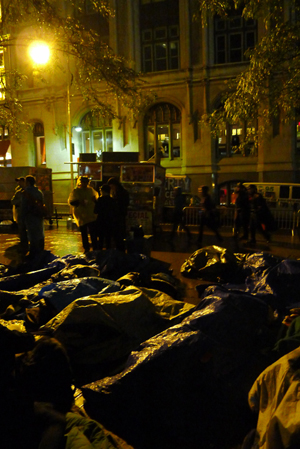 Throughout the night and into the morning, truckers would drive past and honk their horns loudly in solidarity, which was always met with cheers, no matter the hour. We slept on the plain ground covered with only a plastic bag to keep dry because the plan that night was to minimize the amount of sleeping bags and bedding in the park. As 5am approached, a girl came by giving out dry socks to people. Others passed around Sharpies to write the phone number of the lawyers on their body in case of arrest.
More and more people were showing up at the park, and by 6am, it was a sea of bodies as far as you could see in any direction—so far out that any statement over the people’s mic needed to be repeated in three or four ripples. So many faces, so many lights!—from cell phones, candles, video cameras…But when the breaking news came over the crowd—the news that the cleaning/eviction had been canceled—this enormous group was so unified that the words needed no repetition. From the cheers of joy alone, everybody knew. And everybody knew that they had just experienced something absolutely historic, I dare say absolutely spiritual.
Throughout the night and into the morning, truckers would drive past and honk their horns loudly in solidarity, which was always met with cheers, no matter the hour. We slept on the plain ground covered with only a plastic bag to keep dry because the plan that night was to minimize the amount of sleeping bags and bedding in the park. As 5am approached, a girl came by giving out dry socks to people. Others passed around Sharpies to write the phone number of the lawyers on their body in case of arrest.
More and more people were showing up at the park, and by 6am, it was a sea of bodies as far as you could see in any direction—so far out that any statement over the people’s mic needed to be repeated in three or four ripples. So many faces, so many lights!—from cell phones, candles, video cameras…But when the breaking news came over the crowd—the news that the cleaning/eviction had been canceled—this enormous group was so unified that the words needed no repetition. From the cheers of joy alone, everybody knew. And everybody knew that they had just experienced something absolutely historic, I dare say absolutely spiritual.
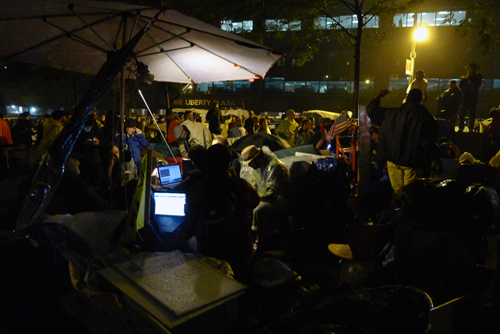
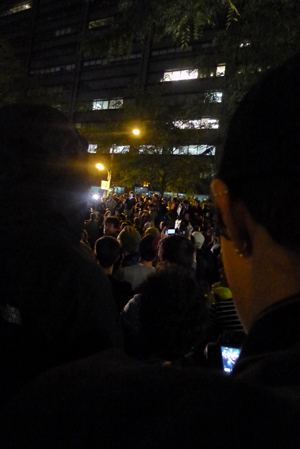
 Throughout the night and into the morning, truckers would drive past and honk their horns loudly in solidarity, which was always met with cheers, no matter the hour. We slept on the plain ground covered with only a plastic bag to keep dry because the plan that night was to minimize the amount of sleeping bags and bedding in the park. As 5am approached, a girl came by giving out dry socks to people. Others passed around Sharpies to write the phone number of the lawyers on their body in case of arrest.
More and more people were showing up at the park, and by 6am, it was a sea of bodies as far as you could see in any direction—so far out that any statement over the people’s mic needed to be repeated in three or four ripples. So many faces, so many lights!—from cell phones, candles, video cameras…But when the breaking news came over the crowd—the news that the cleaning/eviction had been canceled—this enormous group was so unified that the words needed no repetition. From the cheers of joy alone, everybody knew. And everybody knew that they had just experienced something absolutely historic, I dare say absolutely spiritual.
Throughout the night and into the morning, truckers would drive past and honk their horns loudly in solidarity, which was always met with cheers, no matter the hour. We slept on the plain ground covered with only a plastic bag to keep dry because the plan that night was to minimize the amount of sleeping bags and bedding in the park. As 5am approached, a girl came by giving out dry socks to people. Others passed around Sharpies to write the phone number of the lawyers on their body in case of arrest.
More and more people were showing up at the park, and by 6am, it was a sea of bodies as far as you could see in any direction—so far out that any statement over the people’s mic needed to be repeated in three or four ripples. So many faces, so many lights!—from cell phones, candles, video cameras…But when the breaking news came over the crowd—the news that the cleaning/eviction had been canceled—this enormous group was so unified that the words needed no repetition. From the cheers of joy alone, everybody knew. And everybody knew that they had just experienced something absolutely historic, I dare say absolutely spiritual.


 The Beginning is Here
The Beginning is Here
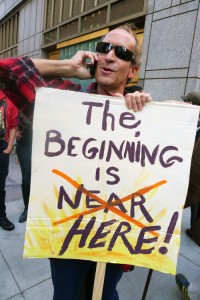 by Ayesha Adamo
With a clear blue sky and weather almost warm enough to go topless (and there were some who did), they couldn't have picked a better day for a protest. On Wednesday 10/5/11, I came down to Occupy with the Columbia University contingent, a truly boisterous group that kept the chanting going non-stop using "the people's mic" technique, which has proved so helpful in an action where no amplification is allowed (everyone repeats after the central speaker so that the message travels out to rings of people further and further away).
Down at Wall Street, all the groups seemed to melt into one another. There were union groups, student groups, a marching band with four tubas, a kindergarten class holding a banner together and chanting in tiny voices to share and not be greedy...just people of every sort imaginable coming together to express the need for a real change in the way things are now. And there didn't need to be just one reason to be there because this is the new way of protesting, of understanding. This is the rhizome, like the world wide web, and the links and connections between one thing and another don't need to make sense in a linear format. They only need to be. Just to be seen by the people in those tall buildings who don't touch public pavement is a win, and a person would have to be cold-as-dead to look out on a crowd like this and not be moved. When I look around at all these faces—their eyes, hearts, the blood in their veins—I feel like I've been waiting for this all my life, and finally...The Beginning is Here.
by Ayesha Adamo
With a clear blue sky and weather almost warm enough to go topless (and there were some who did), they couldn't have picked a better day for a protest. On Wednesday 10/5/11, I came down to Occupy with the Columbia University contingent, a truly boisterous group that kept the chanting going non-stop using "the people's mic" technique, which has proved so helpful in an action where no amplification is allowed (everyone repeats after the central speaker so that the message travels out to rings of people further and further away).
Down at Wall Street, all the groups seemed to melt into one another. There were union groups, student groups, a marching band with four tubas, a kindergarten class holding a banner together and chanting in tiny voices to share and not be greedy...just people of every sort imaginable coming together to express the need for a real change in the way things are now. And there didn't need to be just one reason to be there because this is the new way of protesting, of understanding. This is the rhizome, like the world wide web, and the links and connections between one thing and another don't need to make sense in a linear format. They only need to be. Just to be seen by the people in those tall buildings who don't touch public pavement is a win, and a person would have to be cold-as-dead to look out on a crowd like this and not be moved. When I look around at all these faces—their eyes, hearts, the blood in their veins—I feel like I've been waiting for this all my life, and finally...The Beginning is Here.
 Entering the Temporary Art Zone with Hakim Bey
Entering the Temporary Art Zone with Hakim Bey
 by Ayesha Adamo
“The art, such as it is, comes into existence only in the moment of its own disappearance; afterwards it will be invisible—except to the spirits” – Peter Lamborn Wilson
• • •
by Ayesha Adamo
“The art, such as it is, comes into existence only in the moment of its own disappearance; afterwards it will be invisible—except to the spirits” – Peter Lamborn Wilson
• • •
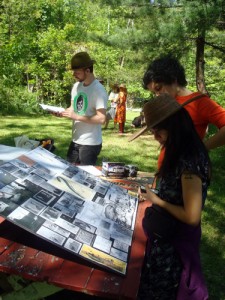 On May 15th 2010, Peter Lamborn Wilson, known to many as Hakim Bey, completed another happening in a series of events aimed at re-enchanting the landscape of forgotten or not-yet-revealed sacred places in upstate New York. These acts of “Endarkenment,” a term Peter uses to mean “fear & respect as well as love for Nature,” are the culmination of his last ten years of research in Ulster County and the surrounding areas. He’s putting the magick he dug up back into the land.
Peter has called this a “temporary landscape installation piece.” It is art that disappears and defies a fetishized place on the
On May 15th 2010, Peter Lamborn Wilson, known to many as Hakim Bey, completed another happening in a series of events aimed at re-enchanting the landscape of forgotten or not-yet-revealed sacred places in upstate New York. These acts of “Endarkenment,” a term Peter uses to mean “fear & respect as well as love for Nature,” are the culmination of his last ten years of research in Ulster County and the surrounding areas. He’s putting the magick he dug up back into the land.
Peter has called this a “temporary landscape installation piece.” It is art that disappears and defies a fetishized place on the 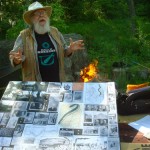 gallery wall. While it bears a resemblance to landscape art, it is more than that, for its goal is to enact the magick of enchantment on the land where each work is performed. The documentation of each of these works includes a hand-written essay, and this May 15th working also featured a large storyboard with pictures and photographs significant to the occasion.
After Peter’s short talk about his research leading up to this event, a few helpers went ahead to make preparations, followed by Peter and his large box labeled “Jukes.” Slowly, the rest of us followed in single file along the narrow towpath where mules used to tread, hauling boats, when the Delaware and Hudson Canal was operational.
gallery wall. While it bears a resemblance to landscape art, it is more than that, for its goal is to enact the magick of enchantment on the land where each work is performed. The documentation of each of these works includes a hand-written essay, and this May 15th working also featured a large storyboard with pictures and photographs significant to the occasion.
After Peter’s short talk about his research leading up to this event, a few helpers went ahead to make preparations, followed by Peter and his large box labeled “Jukes.” Slowly, the rest of us followed in single file along the narrow towpath where mules used to tread, hauling boats, when the Delaware and Hudson Canal was operational.
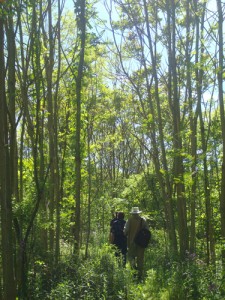 In my understanding of it, there were three main groups called forth for reawakening in this work:
one group that has already disappeared, one that is disappearing, and one that now returns.
The group that has already disappeared is known as the Jukes, or at least that’s the name that flawed social scientists gave to this now infamous community of families when they were the target of eugenics studies in the 1800’s. The flaws in these studies have since been recognized, but what still remains fascinating about the Jukes is the reason that they were targeted for such studies to begin with: they were what Peter calls, “a drop-out society,” not unlike the modern day Ramapough Mountain Indians from New Jersey, who were the subject of the recent New Yorker article “Strangers on the Mountain.” But the Ramapough Mountain Indians,
In my understanding of it, there were three main groups called forth for reawakening in this work:
one group that has already disappeared, one that is disappearing, and one that now returns.
The group that has already disappeared is known as the Jukes, or at least that’s the name that flawed social scientists gave to this now infamous community of families when they were the target of eugenics studies in the 1800’s. The flaws in these studies have since been recognized, but what still remains fascinating about the Jukes is the reason that they were targeted for such studies to begin with: they were what Peter calls, “a drop-out society,” not unlike the modern day Ramapough Mountain Indians from New Jersey, who were the subject of the recent New Yorker article “Strangers on the Mountain.” But the Ramapough Mountain Indians, 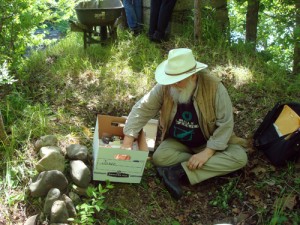 or “Jackson Whites,” as they have been called, have kept their society, even with the skyscrapers of New York threatening on the horizon. They have also kept their mountain - even with the enduring effects of the toxic waste that the old Ford factory dumped on it decades before. The Jukes have not been so lucky – if you can call it luck. While descendants of the Jukes surely still exist, their isolated drop-out community has vanished, and they seem a distant legend in the Ulster County of 2010. All that remains of the Jukes today can be found in a poorhouse graveyard in New Paltz that was re-discovered in 2001, and in the records kept by the poorhouse and those in the archives of the SUNY Albany library. The once vibrant living community of Jukes has now vanished.
or “Jackson Whites,” as they have been called, have kept their society, even with the skyscrapers of New York threatening on the horizon. They have also kept their mountain - even with the enduring effects of the toxic waste that the old Ford factory dumped on it decades before. The Jukes have not been so lucky – if you can call it luck. While descendants of the Jukes surely still exist, their isolated drop-out community has vanished, and they seem a distant legend in the Ulster County of 2010. All that remains of the Jukes today can be found in a poorhouse graveyard in New Paltz that was re-discovered in 2001, and in the records kept by the poorhouse and those in the archives of the SUNY Albany library. The once vibrant living community of Jukes has now vanished.
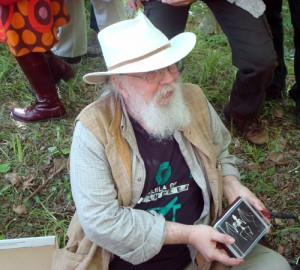 The second group, the group that is in the process of vanishing, is the bat community. All along the East Coast and into the Midwest, bats have been found dead in the hundreds of thousands.
The second group, the group that is in the process of vanishing, is the bat community. All along the East Coast and into the Midwest, bats have been found dead in the hundreds of thousands. 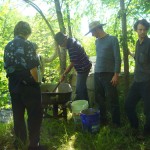 The bats are dying of “white-nose syndrome,” so named for the white fungus, Geomyces destructans, that can be seen on the muzzles of infected bats. It is still uncertain whether the fungus is the disease or whether it is able to take hold of an immune system already weakened by some other disease, though it seems that the fungus itself is the culprit. Bats are a major predator to insects, not just the insects that interfere with us on a hot summer day, but also those that interfere with the growth of crops. The threat of imbalance in the ecosystem, as well as the possibility of extinction for many species of bats, is a serious concern for us all as we watch this community of animals suddenly disappear.
The bats are dying of “white-nose syndrome,” so named for the white fungus, Geomyces destructans, that can be seen on the muzzles of infected bats. It is still uncertain whether the fungus is the disease or whether it is able to take hold of an immune system already weakened by some other disease, though it seems that the fungus itself is the culprit. Bats are a major predator to insects, not just the insects that interfere with us on a hot summer day, but also those that interfere with the growth of crops. The threat of imbalance in the ecosystem, as well as the possibility of extinction for many species of bats, is a serious concern for us all as we watch this community of animals suddenly disappear. 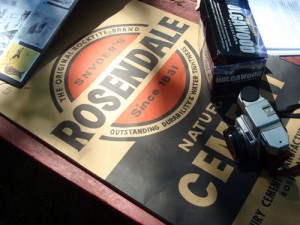 The last group, the one that returns, is the cement itself, which was to be the bonding agent of all that went into this day’s working of Endarkenment. Standing on the aqueduct bridge abutment designed by Roebling in 1850 and overlooking the Rondout Creek, it seemed only fitting that the cement used for this occasion should be Rosendale Natural Cement, which was the business that founded the nearby town of Rosendale during the construction of the Delaware and Hudson Canal. The cement was first discovered in Rosendale during the excavation of the canal bed for the D & H Canal in 1825, and would later be used as one of the materials in the building of the canal itself. Rosendale Natural Cement was also used in the construction of Roebling’s aqueduct bridge, the remaining abutment on which we then stood, and in his later and more famous project, the Brooklyn Bridge. Despite the popularity of Rosendale Cement in the nineteenth century, the introduction of faster-setting Portland Cement meant the end of natural cement production in the twentieth century. By 1970, the last of the cement mines in Rosendale were closed. Natural cement was no longer available.
But in 2004, natural cement made a surprising return when Edison Coatings, Inc decided to resurrect production of Rosendale Natural Cement. The main reason behind this comeback was the need to restore buildings and monuments that were originally constructed using natural cement,
The last group, the one that returns, is the cement itself, which was to be the bonding agent of all that went into this day’s working of Endarkenment. Standing on the aqueduct bridge abutment designed by Roebling in 1850 and overlooking the Rondout Creek, it seemed only fitting that the cement used for this occasion should be Rosendale Natural Cement, which was the business that founded the nearby town of Rosendale during the construction of the Delaware and Hudson Canal. The cement was first discovered in Rosendale during the excavation of the canal bed for the D & H Canal in 1825, and would later be used as one of the materials in the building of the canal itself. Rosendale Natural Cement was also used in the construction of Roebling’s aqueduct bridge, the remaining abutment on which we then stood, and in his later and more famous project, the Brooklyn Bridge. Despite the popularity of Rosendale Cement in the nineteenth century, the introduction of faster-setting Portland Cement meant the end of natural cement production in the twentieth century. By 1970, the last of the cement mines in Rosendale were closed. Natural cement was no longer available.
But in 2004, natural cement made a surprising return when Edison Coatings, Inc decided to resurrect production of Rosendale Natural Cement. The main reason behind this comeback was the need to restore buildings and monuments that were originally constructed using natural cement, 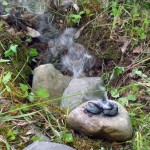 though it turns out that Rosendale Natural Cement is actually “greener” than modern Portland Cement. Due to its much lower firing temperatures and the ease of grinding, natural cement requires less energy to produce.
As we gathered around Peter to watch this artwork in its vanishing, an artwork that is being done for those who vanish, the scent of copal mixed with other incenses - those he had burning on the rock before us, and those of the forest itself.
though it turns out that Rosendale Natural Cement is actually “greener” than modern Portland Cement. Due to its much lower firing temperatures and the ease of grinding, natural cement requires less energy to produce.
As we gathered around Peter to watch this artwork in its vanishing, an artwork that is being done for those who vanish, the scent of copal mixed with other incenses - those he had burning on the rock before us, and those of the forest itself.
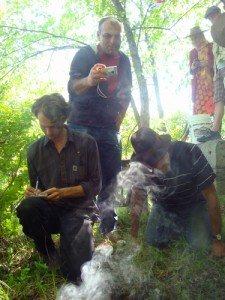 The artwork happened simply. There was little ceremony, perhaps to the confusion of some in attendance who had hoped for a chant or a reading. Peter presented items, one by one, and placed them into a hole in the ground that would be filled with cement. Among these were crystals, a fancy bat skeleton from Carolina Biological, the remains of the incense itself…it made me wonder: must things be buried that they may return? Do we re-enchant our environment when we return to the point zero?
For Peter’s magickal purposes in this act of art, I believe it was significant that the natural cement local to this area, the one element in the work that had gone from a state of disappearance into new life, should be the bonding agent for all the others. As the creation of this temporary installation piece was executed, we watched closely as items disappeared into the hole, as their physical passage from the box labeled “Jukes” into the hole before us disappeared into memory. All of this was then sealed by cement and rocks found around the site the day before. While the process of art may have vanished, the evidence of the act endures. Like the Brooklyn Bridge, the pedestal of the Statue of Liberty, and Grand Central Terminal, this momentary work was made using Rosendale Natural Cement. Its purpose is beyond that of a monument, but the place of Endarkenment was built to last just the same, even if it was now only visible to the spirits, as Peter says.
The artwork happened simply. There was little ceremony, perhaps to the confusion of some in attendance who had hoped for a chant or a reading. Peter presented items, one by one, and placed them into a hole in the ground that would be filled with cement. Among these were crystals, a fancy bat skeleton from Carolina Biological, the remains of the incense itself…it made me wonder: must things be buried that they may return? Do we re-enchant our environment when we return to the point zero?
For Peter’s magickal purposes in this act of art, I believe it was significant that the natural cement local to this area, the one element in the work that had gone from a state of disappearance into new life, should be the bonding agent for all the others. As the creation of this temporary installation piece was executed, we watched closely as items disappeared into the hole, as their physical passage from the box labeled “Jukes” into the hole before us disappeared into memory. All of this was then sealed by cement and rocks found around the site the day before. While the process of art may have vanished, the evidence of the act endures. Like the Brooklyn Bridge, the pedestal of the Statue of Liberty, and Grand Central Terminal, this momentary work was made using Rosendale Natural Cement. Its purpose is beyond that of a monument, but the place of Endarkenment was built to last just the same, even if it was now only visible to the spirits, as Peter says.
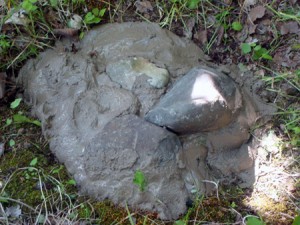 After we traveled back along the narrow towpath and out of the woods, a little boy who was playing pointed up to the sky, and we all saw it: a small rainbow showing itself faintly through the trees, though it hadn’t rained at all. The enchantment was complete, and the signs of this were not only visible to the spirits, but also to us.
*** Peter's statements that have been quoted here are from the press release of a previous related event. You can read his writing on that event here:
http://www.sevenpillarshouse.org/article/first_vanishing_art/
After we traveled back along the narrow towpath and out of the woods, a little boy who was playing pointed up to the sky, and we all saw it: a small rainbow showing itself faintly through the trees, though it hadn’t rained at all. The enchantment was complete, and the signs of this were not only visible to the spirits, but also to us.
*** Peter's statements that have been quoted here are from the press release of a previous related event. You can read his writing on that event here:
http://www.sevenpillarshouse.org/article/first_vanishing_art/
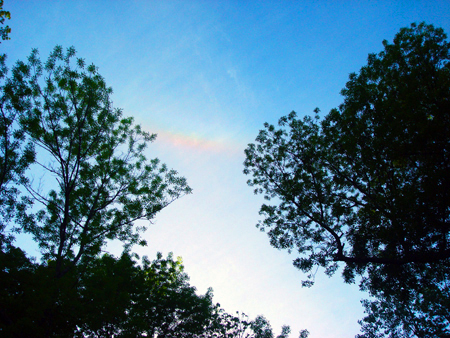 7VPZM2AUKGJM
7VPZM2AUKGJM
 How I Almost Lost a Lung in the Name of Techno
How I Almost Lost a Lung in the Name of Techno
by Ayesha Adamo
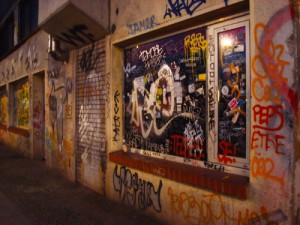 They told me Berghain, Panorama Bar, and an online search admittedly made Watergate and Maria’s sound tempting. But what they didn’t understand was that I can go to a pretentious club with a line out the front - filled with models and yuppie-come-latelies who order bottle service and live to siphon their soulless bodies into fancy suits and stiletto heels (who can dance in that stuff anyway?), albeit to the tune of way shittier music – in my home base town of New York, where the losers wear Prada.
There was no way I was going to Berghain…even though they don’t play top 40 and other sweet sixteen/bar mitzvah soundtracks there like they do in the cipher-of-a-once-great-nightlife-town that is Manhattan. That’s not to say that I needed to help inflate the ego-balloon of the international DJs that I can also hear at the last two worthy dance clubs left in the city-that-used-to-have-a-reason-not-to-sleep either.
I wanted local Berlin, and I was willing to go rogue to get it.
It took some asking around, but eventually I was able to procure a map drawn on a napkin showing how to get to Golden Gate. A subsequent online search back at headquarters (the hotel) turned up a primitive and very basic website, also with a map. X marked a spot near Jannowitzbrücke Station, actually directly across the street from it, and I even managed to excavate a photo of the place – a few hundred square pixels under the train tracks and covered with graffiti: now that’s the kind of nightclub I want to be at.
Naturally, I set out with the hope finding a club that was just a few shades less underground than the place I DJ at in Brooklyn, and this looked like it might be it. I clicked on the links to the myspace pages of the DJs for that night, and was surprised to read “93s to infinity!” at the top of one of the DJ’s pages. A thelemite?!? A sign. This was all I really needed to be 156% sure that I had found the club for me. (You’re only getting that last joke if you’re playing with Magick.)
Showed up at 3 am, which was kind of early, but I didn’t think I’d be able to handle it if I tried for much later, jetlag and all. The door was at the side, but there’s no real way to know that besides luck…and now, by reading my blog. It was also surprisingly quiet, and I wondered if the music had even started yet – it’s hard to hear from the street because the main room is nestled far below at the bottom of a narrow stairwell.
They told me Berghain, Panorama Bar, and an online search admittedly made Watergate and Maria’s sound tempting. But what they didn’t understand was that I can go to a pretentious club with a line out the front - filled with models and yuppie-come-latelies who order bottle service and live to siphon their soulless bodies into fancy suits and stiletto heels (who can dance in that stuff anyway?), albeit to the tune of way shittier music – in my home base town of New York, where the losers wear Prada.
There was no way I was going to Berghain…even though they don’t play top 40 and other sweet sixteen/bar mitzvah soundtracks there like they do in the cipher-of-a-once-great-nightlife-town that is Manhattan. That’s not to say that I needed to help inflate the ego-balloon of the international DJs that I can also hear at the last two worthy dance clubs left in the city-that-used-to-have-a-reason-not-to-sleep either.
I wanted local Berlin, and I was willing to go rogue to get it.
It took some asking around, but eventually I was able to procure a map drawn on a napkin showing how to get to Golden Gate. A subsequent online search back at headquarters (the hotel) turned up a primitive and very basic website, also with a map. X marked a spot near Jannowitzbrücke Station, actually directly across the street from it, and I even managed to excavate a photo of the place – a few hundred square pixels under the train tracks and covered with graffiti: now that’s the kind of nightclub I want to be at.
Naturally, I set out with the hope finding a club that was just a few shades less underground than the place I DJ at in Brooklyn, and this looked like it might be it. I clicked on the links to the myspace pages of the DJs for that night, and was surprised to read “93s to infinity!” at the top of one of the DJ’s pages. A thelemite?!? A sign. This was all I really needed to be 156% sure that I had found the club for me. (You’re only getting that last joke if you’re playing with Magick.)
Showed up at 3 am, which was kind of early, but I didn’t think I’d be able to handle it if I tried for much later, jetlag and all. The door was at the side, but there’s no real way to know that besides luck…and now, by reading my blog. It was also surprisingly quiet, and I wondered if the music had even started yet – it’s hard to hear from the street because the main room is nestled far below at the bottom of a narrow stairwell.
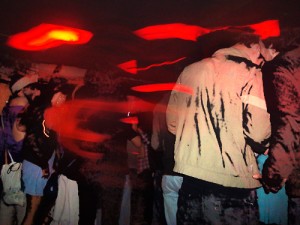 But it sure is loud when you get down there.
And the music! It was like the 1990’s all over again. (I got a little misty eyed). There were dirty sneakers and jeans and cheap beer and bombed out bathroom stalls…heaven. I guess that’s where they got the name Golden Gate.
And the DJs were spinning…could it be? Vinyl?!? Then it really felt like the 90’s all over again. Can’t say I miss dragging around a record box that was double my weight, but compared to New York, it’s nice to see a club that even has turntables. I could see that this place was also equipped with nice CDJs, and what more can a DJ want, really? I mean, besides having the crowd completely entranced and loving it...which they were, myself included.
The only problem was that every person in there was a chain smoker, packed body to rockin’ body in a little black box that was buried underground (literally), and that is how I almost lost a lung in the name of techno.
Sometimes, it’s dangerous goin’ rogue.
When I got back to headquarters, I had to wash my hair 3 times, air out my leather jacket in the window for 2 days, and wrap my dirty clothes in plastic to prevent them from permeating the rest of my luggage with stank. Ah the things we do for love…
http://www.goldengate-berlin.de/html.htm
But it sure is loud when you get down there.
And the music! It was like the 1990’s all over again. (I got a little misty eyed). There were dirty sneakers and jeans and cheap beer and bombed out bathroom stalls…heaven. I guess that’s where they got the name Golden Gate.
And the DJs were spinning…could it be? Vinyl?!? Then it really felt like the 90’s all over again. Can’t say I miss dragging around a record box that was double my weight, but compared to New York, it’s nice to see a club that even has turntables. I could see that this place was also equipped with nice CDJs, and what more can a DJ want, really? I mean, besides having the crowd completely entranced and loving it...which they were, myself included.
The only problem was that every person in there was a chain smoker, packed body to rockin’ body in a little black box that was buried underground (literally), and that is how I almost lost a lung in the name of techno.
Sometimes, it’s dangerous goin’ rogue.
When I got back to headquarters, I had to wash my hair 3 times, air out my leather jacket in the window for 2 days, and wrap my dirty clothes in plastic to prevent them from permeating the rest of my luggage with stank. Ah the things we do for love…
http://www.goldengate-berlin.de/html.htm
 They told me Berghain, Panorama Bar, and an online search admittedly made Watergate and Maria’s sound tempting. But what they didn’t understand was that I can go to a pretentious club with a line out the front - filled with models and yuppie-come-latelies who order bottle service and live to siphon their soulless bodies into fancy suits and stiletto heels (who can dance in that stuff anyway?), albeit to the tune of way shittier music – in my home base town of New York, where the losers wear Prada.
There was no way I was going to Berghain…even though they don’t play top 40 and other sweet sixteen/bar mitzvah soundtracks there like they do in the cipher-of-a-once-great-nightlife-town that is Manhattan. That’s not to say that I needed to help inflate the ego-balloon of the international DJs that I can also hear at the last two worthy dance clubs left in the city-that-used-to-have-a-reason-not-to-sleep either.
I wanted local Berlin, and I was willing to go rogue to get it.
It took some asking around, but eventually I was able to procure a map drawn on a napkin showing how to get to Golden Gate. A subsequent online search back at headquarters (the hotel) turned up a primitive and very basic website, also with a map. X marked a spot near Jannowitzbrücke Station, actually directly across the street from it, and I even managed to excavate a photo of the place – a few hundred square pixels under the train tracks and covered with graffiti: now that’s the kind of nightclub I want to be at.
Naturally, I set out with the hope finding a club that was just a few shades less underground than the place I DJ at in Brooklyn, and this looked like it might be it. I clicked on the links to the myspace pages of the DJs for that night, and was surprised to read “93s to infinity!” at the top of one of the DJ’s pages. A thelemite?!? A sign. This was all I really needed to be 156% sure that I had found the club for me. (You’re only getting that last joke if you’re playing with Magick.)
Showed up at 3 am, which was kind of early, but I didn’t think I’d be able to handle it if I tried for much later, jetlag and all. The door was at the side, but there’s no real way to know that besides luck…and now, by reading my blog. It was also surprisingly quiet, and I wondered if the music had even started yet – it’s hard to hear from the street because the main room is nestled far below at the bottom of a narrow stairwell.
They told me Berghain, Panorama Bar, and an online search admittedly made Watergate and Maria’s sound tempting. But what they didn’t understand was that I can go to a pretentious club with a line out the front - filled with models and yuppie-come-latelies who order bottle service and live to siphon their soulless bodies into fancy suits and stiletto heels (who can dance in that stuff anyway?), albeit to the tune of way shittier music – in my home base town of New York, where the losers wear Prada.
There was no way I was going to Berghain…even though they don’t play top 40 and other sweet sixteen/bar mitzvah soundtracks there like they do in the cipher-of-a-once-great-nightlife-town that is Manhattan. That’s not to say that I needed to help inflate the ego-balloon of the international DJs that I can also hear at the last two worthy dance clubs left in the city-that-used-to-have-a-reason-not-to-sleep either.
I wanted local Berlin, and I was willing to go rogue to get it.
It took some asking around, but eventually I was able to procure a map drawn on a napkin showing how to get to Golden Gate. A subsequent online search back at headquarters (the hotel) turned up a primitive and very basic website, also with a map. X marked a spot near Jannowitzbrücke Station, actually directly across the street from it, and I even managed to excavate a photo of the place – a few hundred square pixels under the train tracks and covered with graffiti: now that’s the kind of nightclub I want to be at.
Naturally, I set out with the hope finding a club that was just a few shades less underground than the place I DJ at in Brooklyn, and this looked like it might be it. I clicked on the links to the myspace pages of the DJs for that night, and was surprised to read “93s to infinity!” at the top of one of the DJ’s pages. A thelemite?!? A sign. This was all I really needed to be 156% sure that I had found the club for me. (You’re only getting that last joke if you’re playing with Magick.)
Showed up at 3 am, which was kind of early, but I didn’t think I’d be able to handle it if I tried for much later, jetlag and all. The door was at the side, but there’s no real way to know that besides luck…and now, by reading my blog. It was also surprisingly quiet, and I wondered if the music had even started yet – it’s hard to hear from the street because the main room is nestled far below at the bottom of a narrow stairwell.
 But it sure is loud when you get down there.
And the music! It was like the 1990’s all over again. (I got a little misty eyed). There were dirty sneakers and jeans and cheap beer and bombed out bathroom stalls…heaven. I guess that’s where they got the name Golden Gate.
And the DJs were spinning…could it be? Vinyl?!? Then it really felt like the 90’s all over again. Can’t say I miss dragging around a record box that was double my weight, but compared to New York, it’s nice to see a club that even has turntables. I could see that this place was also equipped with nice CDJs, and what more can a DJ want, really? I mean, besides having the crowd completely entranced and loving it...which they were, myself included.
The only problem was that every person in there was a chain smoker, packed body to rockin’ body in a little black box that was buried underground (literally), and that is how I almost lost a lung in the name of techno.
Sometimes, it’s dangerous goin’ rogue.
When I got back to headquarters, I had to wash my hair 3 times, air out my leather jacket in the window for 2 days, and wrap my dirty clothes in plastic to prevent them from permeating the rest of my luggage with stank. Ah the things we do for love…
http://www.goldengate-berlin.de/html.htm
But it sure is loud when you get down there.
And the music! It was like the 1990’s all over again. (I got a little misty eyed). There were dirty sneakers and jeans and cheap beer and bombed out bathroom stalls…heaven. I guess that’s where they got the name Golden Gate.
And the DJs were spinning…could it be? Vinyl?!? Then it really felt like the 90’s all over again. Can’t say I miss dragging around a record box that was double my weight, but compared to New York, it’s nice to see a club that even has turntables. I could see that this place was also equipped with nice CDJs, and what more can a DJ want, really? I mean, besides having the crowd completely entranced and loving it...which they were, myself included.
The only problem was that every person in there was a chain smoker, packed body to rockin’ body in a little black box that was buried underground (literally), and that is how I almost lost a lung in the name of techno.
Sometimes, it’s dangerous goin’ rogue.
When I got back to headquarters, I had to wash my hair 3 times, air out my leather jacket in the window for 2 days, and wrap my dirty clothes in plastic to prevent them from permeating the rest of my luggage with stank. Ah the things we do for love…
http://www.goldengate-berlin.de/html.htm

